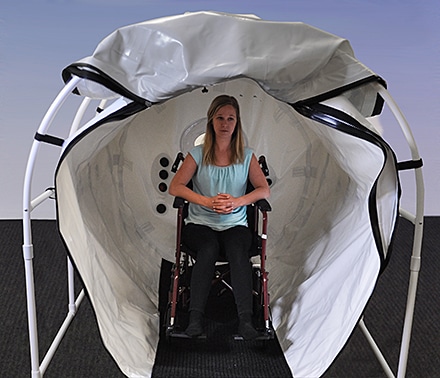July 9, 2024

Definition: HYPER (HIGH) + BARIC (PRESSURE) + OXYGEN = breathing oxygen while under increased atmospheric pressure
Hyperbaric Oxygen Therapy HBOT (HBOT) and Mild Hyperbaric Oxygen Therapy (MHBOT) are highly effective treatments that have been used more and more frequently over the past decade to treat Lyme and other biotoxin illnesses. It helps maximize recovery and relief for Lyme disease and many other conditions. A groundbreaking study by William Fife, M.D. of Texas A&M University demonstrates dramatic improvements in the overall condition of Lyme patients treated with HBOT. It has been shown to reduce pain significantly, modulate the immune system, increase energy, alleviate sleep dysfunction and decrease cognitive dysfunction (brain fog). In many cases patients are able to decrease use of antibiotics.

(mHBOT) is an oxygen therapy. Sessions can vary in length, and happen inside an oxygen-rich, pressurized chamber. Infusing the body with 95% medical grade oxygen under increased atmospheric pressure promotes healing and delivers benefits that breathing supplemental oxygen alone can’t achieve. mHBOT dramatically increases the oxygen in blood plasma, and in the brain, spine, and joint fluid. It has also been shown to significantly increase the ability of cells to produce energy. Sessions can vary in length and it is safe to use electronics in the chamber.
Multiple sessions are most effective. Session amount varies depending on the severity of Lyme. Patients with acute Lyme may only require 1-3 sessions to be most effective. Those with chronic Lyme require between 10 and 40 sessions for permanent long-term benefits.
While a patient is in the hyperbaric oxygen chamber breathing supplemental oxygen under increased pressure, oxygen saturates their red blood cells. The additional pressure causes oxygen molecules to become directly infused into bodily fluids—including plasma, lymph, spinal fluid and interstitial spaces and tissues.
Oxygen is involved in 5,769 known cellular processes. Many diseases thrive in a low- oxygen environment. Lack of oxygen and blood flow to cells plus inflammation causes many things to happen including:
This makes it harder for cells to produce the energy needed to repair, regenerate and keep the body healthy and functioning properly. mHBOT treats common denominators shared by many diseases including low oxygen levels, reduced blood flow and inflammation. It works because patient’s lungs can gather more oxygen than is possible breathing pure oxygen at normal air pressure. Their blood carries oxygen throughout their body. This has a positive impact on many chronic illnesses.
Just like any drug, there are certain “dosages” of hyperbaric oxygen that are appropriate as treatment for certain conditions. There are 3 ways that hyperbaric oxygen dosages can be adjusted: 1) degree of pressure used, 2) amount of oxygen given and 3) duration of treatment, including length of session under pressure, number, and frequency of treatments. The degree of pressure can vary from “mild hyperbaric” (mHBOT) –1.5
Atmospheres Absolute (ATA) and below, to “hyperbaric” (HBOT)— above 1.5 ATA.
Please note: A physician’s prescription is required for HBOT or mHBOT treatment. Discuss your medical history/conditions with your physician before starting treatment. All treatments are monitored with an in-chamber walkie-talkie. Doctors check in on patients but there is no need for them to stay in the room.
What mHBOT Can Do for Lyme
Because mHBOT provides around 10 times the normal amount of oxygen, many body functions are restored, the immune system receives a massive boost and many Lyme patients experience dramatic improvements in their overall health. mHBOT pressure augments other therapies, amplifying the positive effect of antibiotics by driving them deeper into cells for better absorption. In some cases, patients are able to stop using antibiotics and other medications.
HBOT chambers are approved in the U.S. There are many reported benefits of mHBOT in treating traumatic, acute, and chronic diseases and conditions including:
Off Label and FDA Approved Conditions
Licensed physicians are legally approved to use HBOT and mHBOT for any condition they deem appropriate for their patient. While there are currently only 14 FDA “approved” conditions covered by insurance, there are many “off label” conditions that have been treated with great success. Outside the U.S. HBOT and mHBOT are considered the standard of care for many conditions including MS, Cerebral Palsy and other neurological issues.
[one-half-first]
[/one-half-first]
[one-half]
[/one-half]
FDA “Approved” Conditions:
[one-half-first]
[/one-half-first]
[one-half]
[/one-half]
Do not use HBOT or mHBOT if you have:
Use caution using HBOT or mHBOT if you have:
Possible Side Effects
Share on:
A free, open discussion group to explore hyperbaric oxygen therapy, compare home chamber brands, access expert info, and get exclusive member discounts.